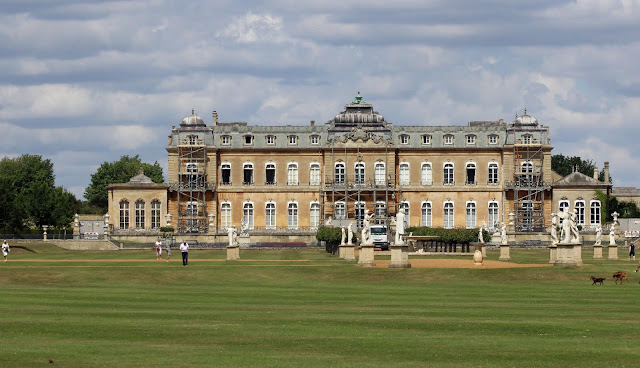Life in the time of Formal Gardens
By Jayne Davis
With many of us around the world going a little stir crazy, I thought I’d share a historical day out from last year. Wrest Park is a stately home with extensive gardens, owned by English Heritage.
The house is relatively modern, having been rebuilt in the 1830s. This post concentrates on the gardens, interesting because parts of them are still very similar to the way they were in the 1700s. Most other stately home gardens have been landscaped to more modern, informal designs.
 |
| The house at Wrest Park. |
In the 17th century, many owners of stately homes modelled their gardens on those at Versailles –how better to emphasise your status than by replicating the gardens of the French kings? The style was based on formal patterns and straight lines, including parterres (flower beds in symmetrical patterns) and usually a long, straight water feature. This print from 1708 shows the Wrest Park gardens with parterres behind the house. The shaded line stretching into the distance is a canal (a rectangular lake).
 |
| Wrest House and gardens in 1708. |
This aerial photo of the gardens at Versailles shows the similarity. The wooded areas beyond the formal gardens were another feature of this type of garden, providing a network of paths and rides, and these were introduced at Wrest Park after the print above was made.
 |
| The gardens at Versailles- Credit: ToucanWings / CC BY-SA (https://creativecommons.org/licenses/by-sa/3.0). |
Today, Wrest Park has some more modern flower gardens close to the house, but still has parterres leading to open spaces and then the Long Water bordered on each side by woodland.
 |
| Part of the parterre, with the Long Water and the Pavilion at the far end. |
 |
| View of the house from the far end of the Long Water. |
The gardens were used for recreation—entertaining one’s guests in lavish style was another way of displaying wealth and status. The Pavilion at the end of the Long Water was used by hunting parties and sometimes for formal dining. It has elaborate trump d’oeil paintings inside, giving the impression of classical pillars and ornate plasterwork inside the dome.
 |
| The Pavilion, seen here from the side. |
The gardens have other structures, dating from various times, including an orangery, the Bowling Green House (although the bowling green is no longer there), a rustic cottage, and various statues and monuments both in the open gardens and in small clearings along the woodland walks.
 |
| One of the many statues in the woodland. |
In the mid-18th century, Capability Brown (more on him in a future post) was asked to remodel parts of the grounds into the new English fashion for a less formal, landscape style. He wasn’t allowed to touch the main parts of the grounds, but softened the edges and added an irregular canal around the edges of the woodland.
 |
| The Chinese Bridge over the informal canal that now surrounds the end of the garden. |
Images:
Wrest House in 1708 from https://commons.wikimedia.org/wiki/File:WrestHouse1708.jpg
Versailles from https://creativecommons.org/licenses/by-sa/3.0
All other photos by the author.
By Jayne Davis
Jayne’s latest book is on pre-order. A Suitable Match is Book 2 in the Marstone Series, but each story can be read as a standalone novel with no cliffhangers.
England, 1782
Lady Isabella has been kept on a tight rein by Lord Marstone, her overbearing father. She's excited when he packs her off to London to make an advantageous match, confident her brother will preserve her from an unsuitable alliance. But when her brother is called away on vital business, he asks Nick Carterton to stand in for him.
Nick, a scholar who relishes the quiet life, has avoided marriage for years but is finally giving in to his father’s request that he seek out a bride. Looking out for a young miss new to society is the last thing he'd choose to do.
Will Nick’s attempts to help merely reinforce Isabella’s resentment at having her life arranged for her? Can Nick keep the headstrong Isabella out of trouble, put off unsuitable suitors, and still find himself a wife?
Jayne Davis
Jayne Davis writes historical romances set in the late Georgian/Regency era, published as both ebooks and paperbacks.
She was hooked on Jane Austen and Georgette Heyer as a teenager, and longed to write similar novels herself. Real life intervened, and she had several careers, including as a non-fiction author under another name. That wasn't quite the writing career she had in mind...
Finally, she got around to polishing up stories written for her own amusement in long winter evenings, and became the kind of author she’d dreamed of in her teens. She is now working on the first few books in the Marstone Series, set in the late Georgian/early Regency period.




No comments:
Post a Comment
See you on your next coffee break!
Take Care,
Mary Anne xxx